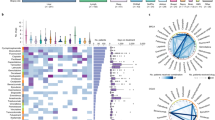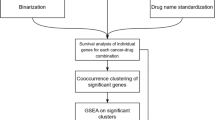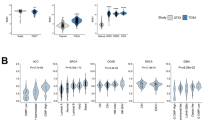Abstract
TZT-1027 is an antimicrotubule agent targeting beta-tubulin that is undergoing clinical development. The genomic response of cancer cells to TZT-1027 was profiled to evaluate its biochemical activity. A lung cancer cell line, PC-14, was exposed to antimicrotubule agents including dolastatins, Vinca alkaloids and taxanes at an equivalent toxicity level. Alterations in the TZT-1027-induced gene expression of ∼600 genes were then examined using microarray technology and the resulting gene profiles were compared with those for cells exposed to the other antimicrotubule agents. A principle component analysis using the whole gene set demonstrated that TZT-1027 produced similar gene profiles to those produced by dolastatin 10, but that these gene profiles differed from those produced by other agents. The agents were classified according to their induced genomic response in a molecular structure-dependent manner. Genes whose expression profiles differed according to drug class included intermediate filaments, extracellular matrix protein and Rho regulatory genes that may be involved in cytoskeletal and angiogenesis processes that are regulated by microtubule dynamics. TZT-1027 produces a unique genomic response profile distinct from that of Vinca alkaloids and taxanes, suggesting that this agent has a different mechanism of action. The selected genes may act as pharmacodynamic biomarkers allowing the unique mode of action of TZT-1027 to be discriminated from those of other antimicrotubule agents.
This is a preview of subscription content, access via your institution
Access options
Subscribe to this journal
Receive 6 print issues and online access
$259.00 per year
only $43.17 per issue
Buy this article
- Purchase on Springer Link
- Instant access to full article PDF
Prices may be subject to local taxes which are calculated during checkout






Similar content being viewed by others
References
Pettit G, Kamano Y, Herald C, Tuinman A, Boettner F, Kizu H et al. The isolation and structure of a remarkable marine animal antineoplastic constituent: dolastatin 10. J Am Chem Soc 1987; 109: 6883–6885.
Saad ED, Kraut EH, Hoff PM, Moore Jr DF, Jones D, Pazdur R et al. Phase II study of dolastatin-10 as first-line treatment for advanced colorectal cancer. Am J Clin Oncol 2002; 25: 451–453.
Vaishampayan U, Glode M, Du W, Kraft A, Hudes G, Wright J et al. Phase II study of dolastatin-10 in patients with hormone-refractory metastatic prostate adenocarcinoma. Clin Cancer Res 2000; 6: 4205–4208.
Krug LM, Miller VA, Kalemkerian GP, Kraut MJ, Ng KK, Heelan RT et al. Phase II study of dolastatin-10 in patients with advanced non-small-cell lung cancer. Ann Oncol 2000; 11: 227–228.
Margolin K, Longmate J, Synold TW, Gandara DR, Weber J, Gonzalez R et al. Dolastatin-10 in metastatic melanoma: a phase II and pharmokinetic trial of the California Cancer Consortium. Invest New Drugs 2001; 19: 335–340.
Miyazaki K, Kobayashi M, Natsume T, Gondo M, Mikami T, Sakakibara K et al. Synthesis and antitumor activity of novel dolastatin 10 analogs. Chem Pharm Bull (Tokyo) 1995; 43: 1706–1718.
Kobayashi M, Natsume T, Tamaoki S, Watanabe J, Asano H, Mikami T et al. Antitumor activity of TZT-1027, a novel dolastatin 10 derivative. Jpn J Cancer Res 1997; 88: 316–327.
Chaplin DJ, Pettit GR, Parkins CS, Hill SA . Antivascular approaches to solid tumour therapy: evaluation of tubulin binding agents. Br J Cancer Suppl 1996; 27: S86–S88.
Otani M, Natsume T, Watanabe JI, Kobayashi M, Murakoshi M, Mikami T et al. TZT-1027, an antimicrotubule agent, attacks tumor vasculature and induces tumor cell death. Jpn J Cancer Res 2000; 91: 837–844.
Natsume T, Watanabe J, Koh Y, Fujio N, Ohe Y, Horiuchi T et al. Antitumor activity of TZT-1027 (Soblidotin) against vascular endothelial growth factor-secreting human lung cancer in vivo. Cancer Sci 2003; 94: 826–833.
Niitani H, Hasegawa K . Phase I studies of TZT-1027, a novel inhibitor of tubulin polymerization. Ann Oncol 1998; 9 (Suppl 2): 360.
de Jonge MJ, van der Gaast A, Planting AS, van Doorn L, Lems A, Boot I et al. Phase I and pharmacokinetic study of the dolastatin 10 analogue TZT-1027, given on days 1 and 8 of a 3-week cycle in patients with advanced solid tumors. Clin Cancer Res 2005; 11: 3806–3813.
Schoffski P, Thate B, Beutel G, Bolte O, Otto D, Hofmann M et al. Phase I and pharmacokinetic study of TZT-1027, a novel synthetic dolastatin 10 derivative, administered as a 1-hour intravenous infusion every 3 weeks in patients with advanced refractory cancer. Ann Oncol 2004; 15: 671–679.
Natsume T, Watanabe J, Tamaoki S, Fujio N, Miyasaka K, Kobayashi M . Characterization of the interaction of TZT-1027, a potent antitumor agent, with tubulin. Jpn J Cancer Res 2000; 91: 737–747.
Fujita F, Koike M, Fujita M, Sakamoto Y, Tsukagoshi S . Antitumor effects of TZT-1027, a novel dolastatin 10 derivative, on human tumor xenografts in nude mice. Gan To Kagaku Ryoho 2000; 27: 451–458.
Watanabe J, Natsume T, Fujio N, Miyasaka K, Kobayashi M . Induction of apoptosis in human cancer cells by TZT-1027, an antimicrotubule agent. Apoptosis 2000; 5: 345–353.
Natsume T, Kobayashi M, Fujimoto S . Association of p53 gene mutations with sensitivity to TZT-1027 in patients with clinical lung and renal carcinoma. Cancer 2001; 92: 386–394.
Natsume T, Nakamura T, Koh Y, Kobayashi M, Saijo N, Nishio K . Gene expression profiling of exposure to TZT-1027, a novel microtubule-interfering agent, in non-small cell lung cancer PC-14 cells and astrocytes. Invest New Drugs 2001; 19: 293–302.
DeRisi JL, Iyer VR, Brown PO . Exploring the metabolic and genetic control of gene expression on a genomic scale. Science 1997; 278: 680–686.
Parsons AB, Brost RL, Ding H, Li Z, Zhang C, Sheikh B et al. Integration of chemical-genetic and genetic interaction data links bioactive compounds to cellular target pathways. Nat Biotechnol 2004; 22: 62–69.
Baetz K, McHardy L, Gable K, Tarling T, Reberioux D, Bryan J et al. Yeast genome-wide drug-induced haploinsufficiency screen to determine drug mode of action. Proc Natl Acad Sci USA 2004; 101: 4525–4530.
Kung C, Kenski DM, Dickerson SH, Howson RW, Kuyper LF, Madhani HD et al. Chemical genomic profiling to identify intracellular targets of a multiplex kinase inhibitor. Proc Natl Acad Sci USA 2005; 102: 3587–3592.
Gunther EC, Stone DJ, Gerwien RW, Bento P, Heyes MP . Prediction of clinical drug efficacy by classification of drug-induced genomic expression profiles in vitro. Proc Natl Acad Sci USA 2003; 100: 9608–9613.
DeVita VT, Hellman S, Rosenberg SA . Cancer: Principles and Practice of Oncology, 7th edn, Lippincott Williams & Wilkins (LWW): Philadelphia, 2004.
Jordan MA, Wilson L . Microtubules as a target for anticancer drugs. Nat Rev Cancer 2004; 4: 253–265.
Diaz JF, Andreu JM . Assembly of purified GDP-tubulin into microtubules induced by taxol and taxotere: reversibility, ligand stoichiometry, and competition. Biochemistry 1993; 32: 2747–2755.
Jordan A, Hadfield JA, Lawrence NJ, McGown AT . Tubulin as a target for anticancer drugs: agents which interact with the mitotic spindle. Med Res Rev 1998; 18: 259–296.
Gupta S, Bhattacharyya B . Antimicrotubular drugs binding to Vincadomain of tubulin. Mol Cell Biochem 2003; 253: 41–47.
Bai RL, Paull KD, Herald CL, Malspeis L, Pettit GR, Hamel E . Halichondrin B and homohalichondrin B, marine natural products binding in the Vincadomain of tubulin. Discovery of tubulin-based mechanism of action by analysis of differential cytotoxicity data. J Biol Chem 1991; 266: 15882–15889.
Etienne-Manneville S, Hall A . Rho GTPases in cell biology. Nature 2002; 420: 629–635.
Sahai E, Marshall CJ . RHO-GTPases and cancer. Nat Rev Cancer 2002; 2: 133–142.
Board PG, Coggan M, Chelvanayagam G, Easteal S, Jermiin LS, Schulte GK et al. Identification, characterization, and crystal structure of the Omega class glutathione transferases. J Biol Chem 2000; 275: 24798–24806.
Schisselbauer JC, Silber R, Papadopoulos E, Abrams K, LaCreta FP, Tew KD . Characterization of glutathione S-transferase expression in lymphocytes from chronic lymphocytic leukemia patients. Cancer Res 1990; 50: 3562–3568.
Ban N, Takahashi Y, Takayama T, Kura T, Katahira T, Sakamaki S et al. Transfection of glutathione S-transferase (GST)-pi antisense complementary DNA increases the sensitivity of a colon cancer cell line to adriamycin, cisplatin, melphalan, and etoposide. Cancer Res 1996; 56: 3577–3582.
Anand-Apte B, Bao L, Smith R, Iwata K, Olsen BR, Zetter B et al. A review of tissue inhibitor of metalloproteinases-3 (TIMP-3) and experimental analysis of its effect on primary tumor growth. Biochem Cell Biol 1996; 74: 853–862.
Hiraoka N, Allen E, Apel IJ, Gyetko MR, Weiss SJ . Matrix metalloproteinases regulate neovascularization by acting as pericellular fibrinolysins. Cell 1998; 95: 365–377.
Anand-Apte B, Pepper MS, Voest E, Montesano R, Olsen B, Murphy G et al. Inhibition of angiogenesis by tissue inhibitor of metalloproteinase-3. Invest Ophthalmol Vis Sci 1997; 38: 817–823.
Qi JH, Ebrahem Q, Moore N, Murphy G, Claesson-Welsh L, Bond M et al. A novel function for tissue inhibitor of metalloproteinases-3 (TIMP3): inhibition of angiogenesis by blockage of VEGF binding to VEGF receptor-2. Nat Med 2003; 9: 407–415.
Mosmann T . Rapid colorimetric assay for cellular growth and survival: application to proliferation and cytotoxicity assays. J Immunol Methods 1983; 65: 55–63.
Chomczynski P, Sacchi N . Single-step method of RNA isolation by acid guanidinium thiocyanate-phenol-chloroform extraction. Anal Biochem 1987; 162: 156–159.
Hosack DA, Dennis Jr G, Sherman BT, Lane HC, Lempicki RA . Identifying biological themes within lists of genes with EASE. Genome Biol 2003; 4: R70.
Dennis Jr G, Sherman BT, Hosack DA, Yang J, Gao W, Lane HC et al. DAVID: database for annotation, visualization, and integrated discovery. Genome Biol 2003; 4: P3.
Acknowledgements
This study was supported in part by a Grant-in-Aid for Cancer Research and the 3rd Term Comprehensive 10-Year Strategy for Cancer Control from the Ministry of Health, Labour and Welfare, Tokyo, Japan. K Nishio and T Shimoyama designed the study. T Shimoyama and K Nishio prepared the manuscript. Y Koh and T Natsume undertook the study. T Shimoyama and T Hamano performed the statistical analysis. T Shimoyama is the recipient of a Research Resident Fellowship from the Foundation of Promotion of Cancer Research in Japan.
Author information
Authors and Affiliations
Corresponding author
Additional information
Duality of Interest
None declared.
Supplementary Information accompanies the paper on The Pharmacogenomics Journal website (http://www.nature.com/tpj).
Supplementary information
Rights and permissions
About this article
Cite this article
Shimoyama, T., Hamano, T., Natsume, T. et al. Reference profiling of the genomic response induced by an antimicrotubule agent, TZT-1027 (Soblidotin), in vitro. Pharmacogenomics J 6, 388–396 (2006). https://doi.org/10.1038/sj.tpj.6500386
Received:
Revised:
Accepted:
Published:
Issue Date:
DOI: https://doi.org/10.1038/sj.tpj.6500386
Keywords
This article is cited by
-
Autophagy Plays a Cytoprotective Role During Cadmium-Induced Oxidative Damage in Primary Neuronal Cultures
Biological Trace Element Research (2015)
-
Nature: a vital source of leads for anticancer drug development
Phytochemistry Reviews (2009)



